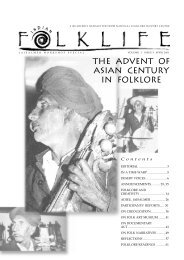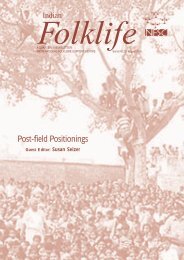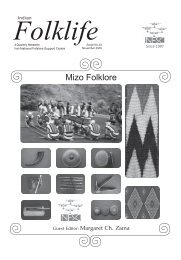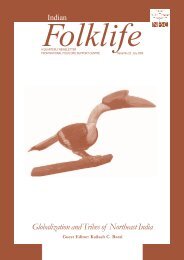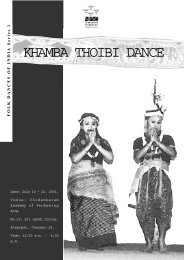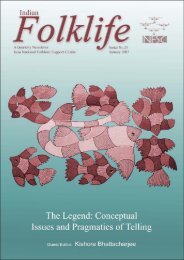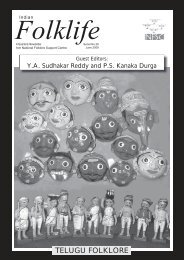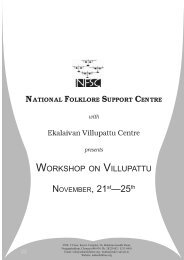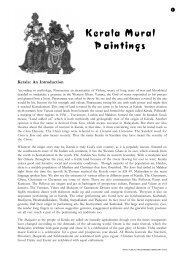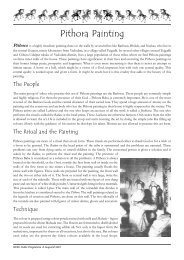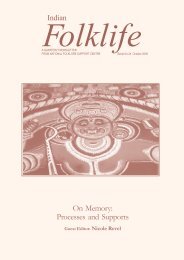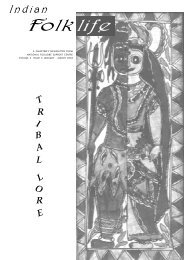Tripura Folklore - Wiki - National Folklore Support Centre
Tripura Folklore - Wiki - National Folklore Support Centre
Tripura Folklore - Wiki - National Folklore Support Centre
You also want an ePaper? Increase the reach of your titles
YUMPU automatically turns print PDFs into web optimized ePapers that Google loves.
E D I T O R I A L<br />
SAROJ CHAUDHURI<br />
Retired Reader in English,<br />
Department of Higher Education,<br />
Government of <strong>Tripura</strong>.<br />
E mail: showrose@rediffmail.com<br />
<strong>Tripura</strong>, a small North-eastern state of India, possesses the unique character of a confluence.<br />
There are as many as nineteen ethnic groups among its ancient inhabitants; added to<br />
them are the Bengalis, the Manipuris, members from other Indian communities, even<br />
descendants of Portuguese soldiers under the service of <strong>Tripura</strong> Kings. All these people have<br />
been living in the state for generations and constitute the population of the state. There is a<br />
confluence of ethnic groups, of traditions and of culture, and yet, it is not the ‘melting pot’<br />
where the distinctive identities are lost. Each stream has its own distinctive character, and yet,<br />
there is a unique synthesis. There is no invasion, no confrontation and no inherent conflict.<br />
Cultural dissemination and cultural assimilation are regarded as essential features of civilisation;<br />
even where these processes have been at work in this land, it has been without transgressions.<br />
This synthesis has been achieved with a true spirit of acceptance and mutual regard. Culture<br />
and tradition are best borne by folklores and oral literature. In the study of oral literature of<br />
<strong>Tripura</strong>, it is interesting to note that while folklores have retained their originality; folk lore from<br />
each source depicts a world of its own-with its faiths, beliefs, values, norms and ways of life.<br />
It will not be just or fair to presume that folk tales from two different sources never have<br />
anything in common amongst them. Values and norms are more or less universal in nature.<br />
Taboo on incest may be reflected in the oral literature of many communities. “It is a great pity<br />
that most of the peoples of the world do not realise how many folklore they have in common”<br />
(Allan Dundes). Early man’s concept of creation also might have imaginative similarity. This may<br />
account for the similarity between the Chakma tale of Genesis and the Santhal tale of Genesis.<br />
There is a discernible similarity in the concept of endless placid water at the beginning; the<br />
amphibian (tortoise / crab) being instrumental in creating land; the Creator creating life out of the<br />
dirt of his own body etc. Another reason for similarity can be the similar life-conditions. When<br />
the occupations for livelihood are the same, and almost the same privileges and predicaments<br />
guide the living, similar ideas can be reflected in folklores. Yet another reason for similarity can<br />
be identified among the folklores of different ethnic groups, barring a few exceptions, when<br />
their cultural matrix is more or less homogeneous. Similarity need not concern the readers, the<br />
only concern can be when there is mark of deliberate imposition.<br />
There are about a score of ethnic groups in <strong>Tripura</strong>, and each has a treasure trove of folklores.<br />
The Mogs, the Chakmas, the Tripuris and the Bengalis have prominent cultural entities, and<br />
they constitute the main sources of the variegated oral literary pattern. Manipuri oral literature<br />
carries the legacy of the homeland. Tripuris, Reans, Noatias, Jamatias, Rupinis, Kolois,<br />
Murasings and Uchois use Kokborok, the state language besides Bengali. Methodical collection,<br />
categorisation, analysis and interpretation of oral literature is quite young in <strong>Tripura</strong>. In view<br />
of the huge and varied range, it will take quite some time. Therefore, any effort in the field is<br />
bound to appear insufficient and incomplete. This effort is nothing more than a humble attempt<br />
to introduce the huge and enchanting territory of oral literature of <strong>Tripura</strong> to the rest of the<br />
world. It is heartening to note that a group of dedicated and enthusiastic scholars are engaged in<br />
exploring the field. With the establishment of North East <strong>Centre</strong> for Oral Literature in Agartala,<br />
the process will surely gain momentum.<br />
I express my heartfelt gratitude to MD Muthukumaraswamy who offered me the honour<br />
of editing this issue as Guest Editor. I have very little contribution of<br />
my own. I am indebted to the scholars: Dr. Nanigopal Chakrabarti.<br />
Sri. Chandrakanta Murasingh, Sri. Kumud Kundu Chaudhuri,<br />
Sri. Gitya Kumar Reang, Sri. Santimay Chakrabarti, Sri. Sunil Debbarma.<br />
Dr. Mrs. Arundhati Ray, Sri. Rupak Debnath, Dr. Nirmal Das and many<br />
others, whose collections I have compiled. ❆<br />
INDIAN FOLKLIFE SERIAL NO.35 JANUARY 2010



